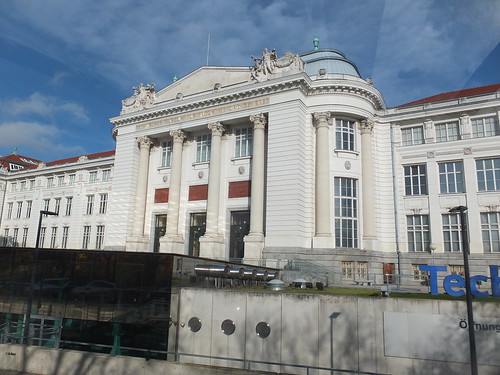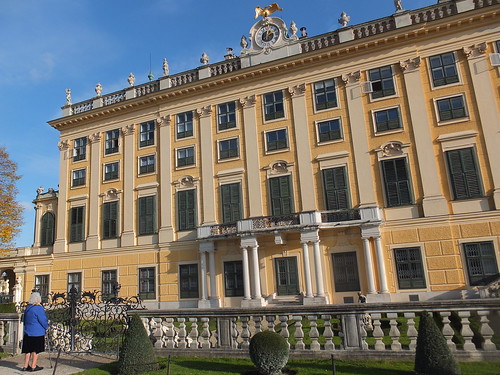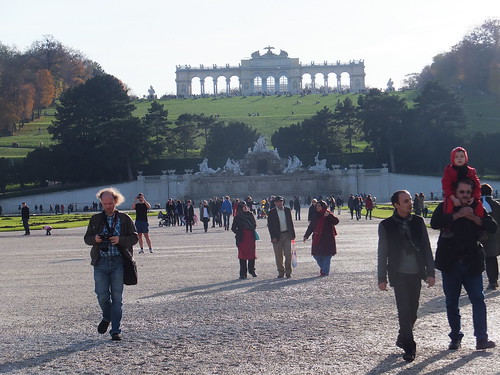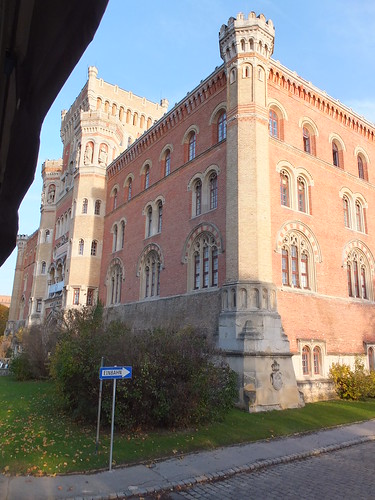Trip to Schoenbrunn Palace, Sunday morning, 9th November 2014
Since our 'Red Route' Big Bus Tour the previous day (described in Part 3) had been a success, we used the 'Blue Route' Big Bus Tour to get to Schoenbrunn. There's a map of Vienna showing the 'Blue Route' here.
After a generous breakfast at the Ambassador Hotel, we walked to the usual bus stop in the Walfischgasse to catch the ten o'clock Big Bus. The bus joined the clockwise Ringstrasse before taking a left turn into Mariahilferstrasse. At Esterhazypark, we passed another World War II Flak Tower (we'd encountered one the day before as described in Part 3). The tall, rectangular concrete tower would have been striking in any case but this one was brought back into use in 1957 as an aquarium, the Haus des Meeres with a lean-to glazed section. Even more striking is the artwork by conceptual artist Lawrence Weiner in 1991 - the top section of the building has been painted white with the slogan 'SMASHED TO PIECES (IN THE STILL OF THE NIGHT)' added in large block capitals in both English and German.

The former Flak Tower in Esterhazypark, now the 'Haus des Meeres'.
We continued through the prosperous West End of the city, eventually passing the Technical Museum on our right. Their website is here.
 The Technisches Museum.
The Technisches Museum.
The sun brightened, revealing the glowing autumn colours of the trees which (in contrast with England) still retained most of their foliage. Our route crossed a subway line (U4) and a drainage channel but it looked quite rural as we approached Schoenbrunn Palace.
 A rural scene near Schoenbrunn Palace.
A rural scene near Schoenbrunn Palace.
We drove past the entrance to the Schoenbrunn Palace, which is flanked by two tall obelisks and opens onto a large courtyard with the rear elevation of the main palace building beyond. Schoenbrunn is reputed to be the most popular tourist attraction in Austria, so I was not surprised to see lots of people around. Our bus continued on the public road about 400 metres to the car park and bus unloading point. Rita and I joined the crowds walking towards the palace entrance. Surprisingly, entrance to the park and gardens is free, but palace tours and other attractions require payment.
Just inside the entrance, we found a large ticket office. This was heaving with people, making it difficult to work out what our options were. A rather harassed lady was manning an enquiry desk so we queued for a minute or two but, before we got to her desk, she abandoned her post. There seemed to be three different channels, one for automatic ticket machines (the machines themselves were invisible because of the crush of visitors), one for a series of ticket windows manned by sales staff and one for groups and others with pre-booked tickets. Then we realised that the 'pre-booked' channel also provided access to a small cafe area which was fairly quiet, so we opted for a drink first. Waiter service is still usual in Vienna - a very pleasant change from the self-service common in England. As we watched the adjacent queues, the crowding seemed to become worse, not better, so I volunteered to sort out the tickets.
The lady from the enquiry desk was now standing near the entrance and appeared to be shepherding all newcomers to the queue for the ticket windows. After a little thought, I decided to join the ticket machine queue which appeared to be smaller and I thought should move quicker. As my queue slowly shuffled forward, I could see that there were five modern touch-screen ticket machines. Tickets were not being issued as quickly as I'd hoped, because most people seemed to be having trouble and often going back to the start of the ticketing process. I suppose this is very similar to the problems people encounter using automatic ticket machines in England. I carefully watched people on different machines to see how they worked. There was a range of languages available, a restricted range of tickets (compared with the ticket windows) and credit cards were accepted. When my turn came, I was able to purchase our tickets quickly and without error. By this time, Rita was checking out the souvenir shop.
 Schoenbrunn: View from the courtyard, looking back towards the main entrance.
Schoenbrunn: View from the courtyard, looking back towards the main entrance.
We'd elected to take the 'Imperial Tour', visiting 20 rooms in the palace, as opposed to the 'Grand Tour' taking in 40 rooms. We crossed the courtyard and, after some confusion on my part, found the correct entrance to the palace building, joining another queue waiting to enter the tour proper. Audio Guides or a written description of the tour were available. Rita took the Audio Guide whilst I elected for the 'hard copy'. Photography is prohibited inside the palace so I've no record of the rooms we inspected but it was an interesting tour. In fact, when we finished our tour, Rita was all for extending our ticket to see the other 20 rooms! However, by the time Rita had examined the extensive souvenir shop and we'd arranged our return to the ground floor by lift, Rita was happy to see part of the gardens instead.
 Rita studies the garden elevation of the palace.
Rita studies the garden elevation of the palace.
 View from the palace, looking towards the Gloriette on its imposing hilltop site.
View from the palace, looking towards the Gloriette on its imposing hilltop site.
 A view of the courtyard elevation of the palace, taken as we left.
A view of the courtyard elevation of the palace, taken as we left.
The bus on the 'Blue Route only runs every hour, so we decided to conclude our visit and hurry back to to bus stop. We only had a few minutes to wait before the bus picked us up. The bus uses a different route on the return, so we saw a little more of the city. We passed the recently-modernised central railway station and stopped at the huge brick and stone bulk of the Arsenal. This complex is now home to the Museum of Military History, Vienna. The museum's official website is here.

The Museum of Military History, Vienna
The final bus stop before the city was at the Belvedere, two magnificent 18th century palaces built as the summer residence for Prince Eugene of Savoy (1663-1736). The Belvedere has a splendid, comprehensive website here including history, illustrations of the sumptuous interiors and details of the various art exhibitions held here. From the website, I even learnt about the group of Austrian artists formed in 1899 called the Hagenbund.
 View from Gurtel Landstrasse of the Belvedere gardens showing the lake and, in the background, the Upper Belvedere Palace.
View from Gurtel Landstrasse of the Belvedere gardens showing the lake and, in the background, the Upper Belvedere Palace.
We were now back on familiar territory. Our bus passed the Soviet War Memorial, negotiated the Schwartenplatz with the Palais Archduke Ludwig Viktor on our right and finally alighted in the Walfischgasse.
 The Soviet War Memorial.
The Soviet War Memorial.
However, we were not finished yet. In a few minutes, a 'Red Route' Big Bus arrived and we set off for the Danube Tower, which I'll describe in the next part.
Related posts on this website
A Weekend in Vienna (Part 1).
A Weekend in Vienna (Part 2).
A Weekend in Vienna (Part 3).
A Weekend in Vienna (Part 5).
Books
[1] 'Imperial Vienna' by Lina Schnorr, published by H.B. Medienvertrieb GesmbH (ISBN: 978-3-9502396-9-0).
[2] 'Vienna: Art and Architecture', by various authors, published by h.f. ullmann (ISBN 978-3-8331-6006-6).
My Pictures
Click on any picture above for an uncropped view or search the albums below for pictures at different resolutions which may be downloaded for non-commercial purposes.
The albums below relate to this post:-
'Blue Route' City Tour.
Schoenbrunn Palace.
The collection below includes all the albums on the Vienna trip:-
Austria.
